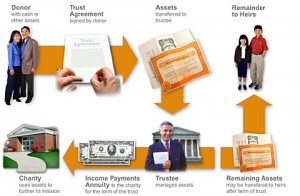If your charitable giving is limited to cash donations to organizations and causes you love, you may want to take a more strategic approach. Who wouldn’t want to pay less in taxes while at the same time making your charitable giving go further and do more than you ever dreamed!

The TOP 4 Charitable Giving Strategies
#1 Beneficiary Designations
Donors can designate a charitable organization as a beneficiary of their will, retirement plan, individual retirement account (IRA), life insurance policy, annuity, or any other asset that passes by contract, such as a payable on death account. The charity can be the primary beneficiary or one of several beneficiaries. Accounts with named beneficiaries are generally not subject to probate; however, designating a charitable beneficiary under a will is subject to probate. Distributions of retirement assets that would be subject to income tax, such as from a traditional IRA, are also exempt from income tax when passing to a charitable organization.
#2 Charitable Remainder Trust
If you want to make a future gift while retaining the right to income from the assets during your lifetime, you could consider a Charitable Remainder Trust. This is an irrevocable trust funded with either cash or property. You retain the right to an income stream that is either a fixed amount or a fixed percentage, such as with a Charitable Remainder Annuity Trust (CRAT) or Charitable Remainder Unitrust (CRUT). Income is paid for a number of years or for the life of the income beneficiary. When the trust ends, the assets pass to the charitable entity. You may be entitled to a tax deduction when you transfer assets to the trust. Also, by donating highly appreciated property to the trust rather than selling it and donating cash, you avoid incurring capital gain tax on the sale of the property since the trust, not you, owns the property. Keep in mind that such a trust is irrevocable, so you cannot terminate it or change the terms (other than retaining a power to change charitable beneficiaries). Also, the assets in the trust will not be available for your heirs.
#3 Charitable Lead Trust
Like the CRAT or CRUT, the Charitable Lead Trust makes periodic payments for a term of years or for life, but the payments go to a charitable entity rather than to the donor or another individual. When the trust ends, the remaining assets return to you or pass to other noncharitable beneficiaries, such as your children. Depending on how the trust is structured, you may be entitled to an income tax charitable deduction when assets are transferred to the trust.
#4 Donor-Advised Fund
If you would like to make multiple gifts but are tired of the paperwork, consider creating a donor advised fund. This is a charitable fund managed by a community foundation or a charitable entity created by a bank or other organization.
Contributions to a Donor-Advised Fund are tax deductible; however, assets transferred to the fund do not need to be immediately distributed to a charity. You may retain the ability to make recommendations for distributions to charitable beneficiaries; helpful if you want to take a charitable deduction but are not yet sure which charities you want to support.
These charitable giving methods may allow you or your heirs to benefit from your assets while providing needed funds to charity during your lifetime. If any of these options interest you, contact us now info@stewardshipworks.org to see if which of these planned gift strategies can benefit your overall estate plan.
 Donors do not consciously omit information, but they only reveal what is necessary to answer your questions. And isn’t the typical question, “Are you willing to increase your donation amount this year?”
Donors do not consciously omit information, but they only reveal what is necessary to answer your questions. And isn’t the typical question, “Are you willing to increase your donation amount this year?” Tonight’s first presidential debate signals that the 2012 election is fast approaching. Regardless of the occupant in the oval office in 2012, tax changes are inevitable. Leon C. LaBrecque addresses many of your concerns in his article,
Tonight’s first presidential debate signals that the 2012 election is fast approaching. Regardless of the occupant in the oval office in 2012, tax changes are inevitable. Leon C. LaBrecque addresses many of your concerns in his article,